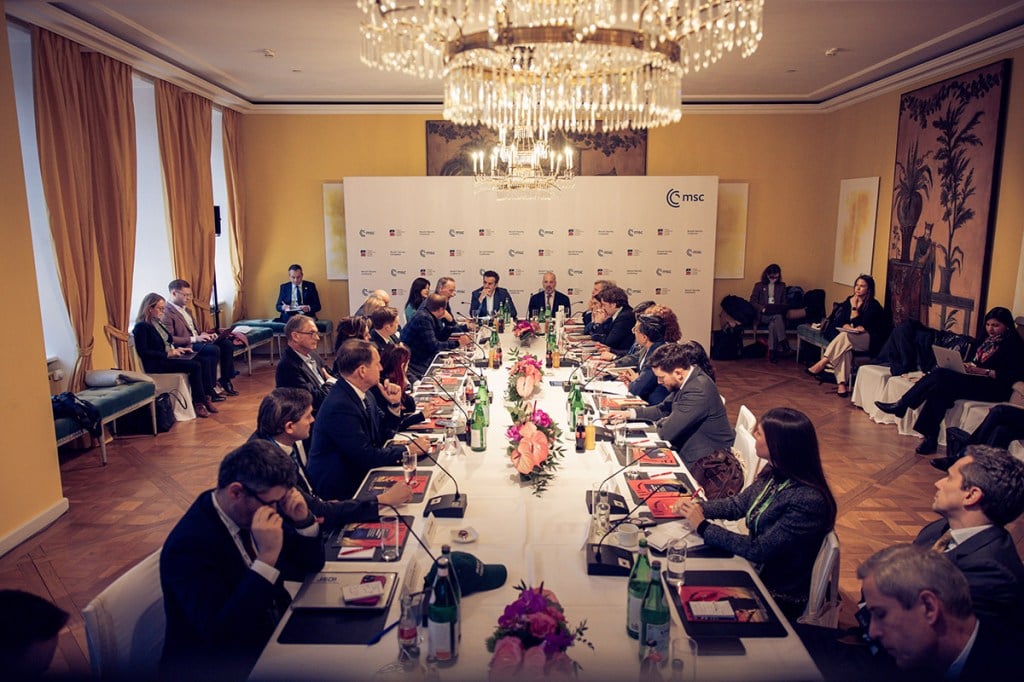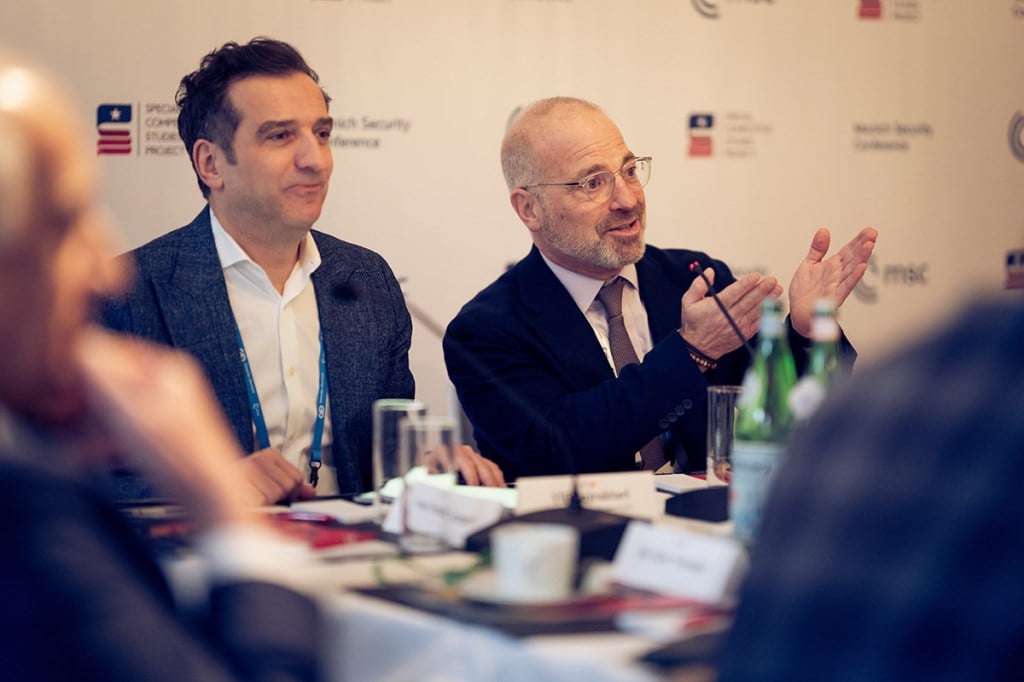Competition and Disruption in the Age of AI
Imagining a Tehran Security Conference
A synthesis report produced by FP Analytics, in partnership with the Special Competitive Studies Project
Amid the intensifying great power competition between the United States and China, Artificial Intelligence (AI) is poised to transform the global economy and international security. The technology’s full effects remain uncertain but will likely be enormous, necessitating proactive effort across sectors to anticipate and prepare for its far-reaching implications.
To this end, the Special Competitive Studies Project partnered with FP Analytics to convene and produce a red-teaming exercise at the 2025 Munich Security Conference. The simulation asked 28 experts and practitioners across the public and private sectors to envision a hypothetical Tehran Security Conference (TSC), mirroring the Munich Security Conference but organized by China, Russia, Iran, and North Korea: a group of nations that some have dubbed the “Axis of Disruptors” given their shared opposition to the U.S.-led international order. Participants were presented with a series of hypothetical events, based on research, pertaining to AI competition and tasked to think through how nations attending the fictional TSC would respond. This synthesis report distills key takeaways from the red-teaming exercise and its implications for stakeholders across defense, technology, and international affairs.
Premise of the Exercise: A Rapidly Approaching AI Future
The hypothetical scenario began in February 2026, with the announcement that leading American technology companies were quickly approaching artificial general intelligence (AGI): an AI system that can match or surpass human cognitive abilities across a wide range of tasks, including military applications. The inaugural TSC convenes in response to this announcement, with invitations extended to nations aiming to counter Western geopolitical influence, such as those in BRICS and the Shanghai Cooperation Organization. During the conference, the United States and its allies designate AI data centers as critical infrastructure, signaling the increased centrality of AI to their economies, societies, and national security.
Midway through the exercise, the simulated events fast-forwarded by one year to the second annual TSC. The intervening year saw intensified competition between the rival blocs, such as sweeping sanctions against Iran; tighter export controls on chips, software, and equipment related to the AGI race; and renewed discussions among TSC nations on de-dollarization through a shared cryptocurrency. In a moderated discussion, participants assessed how nations attending the TSC would respond to these developments, shedding light on potential strategic implications of advanced AI.
Key Takeaways from the Simulated Tehran Security Conference
1. In this scenario, TSC nations were expected to step up their collaboration across the technological, military, and economic domains.
Given their shared opposition to a U.S.-led security order, TSC nations would likely perceive rapid gains in American AI capabilities as a threat to their national interests. In response, they could seek to accelerate their own investments in chips, semiconductors, and AI development and connectivity infrastructure, such as data centers, cloud storage, and deep-sea cables, in addition to attempting to steal American intellectual property. China, in particular, may try to saturate the so-called “Global South” with its technology at relatively low prices to entrench its preferred tech standards and infrastructure and prevent the United States from establishing competing norms regarding data sharing or privacy. To advance these projects, the TSC organizers may reach out to BRICS countries with major regional economies and large populations, like India and Indonesia.
Beyond AI, the attending nations may also deepen their economic and conventional military cooperation. Given the countries’ respective military needs and comparative advantages, possible areas of defense collaboration include shipbuilding, advanced drones, high-performance jet engines, hypersonic weapons, and submarine technology. Increased intelligence sharing would also be likely, while nations that are interested in de-dollarization could develop shared cryptocurrencies to avoid the increasing weaponization of the U.S. dollar.
2. TSC collaboration and use of AI may extend to hostile action against the United States and its allies to slow or disrupt the U.S. pursuit of AGI.
The possibility that AGI could confer major, durable advantages to whichever nation attains it first may prompt TSC attendees to take drastic measures to undermine U.S. interests and advance their own. TSC nations could, for example, consider coordinated attacks on Western data centers or the power plants that service them, through either cyber warfare, acts of sabotage, or kinetic strikes. TSC nations could also resort to politically motivated assassinations or to military action in contested regions, such as blockading Taiwan, to gain leverage over the United States. As TSC organizers develop their own AI capabilities, they could also weaponize AI to undermine Western intelligence systems or augment ongoing social engineering or information warfare efforts in democratic countries.

3. Autocratic governments may also wish to develop or share AI tools through which to censor, surveil, and manipulate their domestic populations.
Advanced AI stands to empower governments to advance their goals at home as well as abroad. The ability to quickly process and interpret massive amounts of data — including facial recognition data, satellite imaging, or troves of social media content — could help authoritarian regimes clamp down on internal opposition, protests, or political dissidents. Meanwhile, advanced AI’s ability to create and distribute realistic text, images, videos, and synthetic voices is a potential boon for “deepfake” propaganda campaigns and information warfare that manipulates public opinion. Superintelligent AI systems that recursively self-improve could outpace human efforts to counter or undo these abuses, potentially locking in authoritarian systems. Finally, even AI systems that are developed without an intent to advance authoritarianism may inadvertently do so if they are trained on data — such as Mandarin-language internet content from within China’s firewall — that has itself been censored to filter out content that is undesirable to authoritarian regimes.
4. Internal instability, diverging interests, and steep political, technological, and economic challenges could limit collaboration among TSC countries.
While TSC nations may strengthen their bilateral relationships, questions linger on the extent to which they could — and would want to — collaborate as one cohesive alliance. China is the only TSC nation with the chips, talent, or funding necessary to challenge the United States for AI dominance. Given this reality, Beijing may have little incentive to share these advantages with other TSC attendees. Also, despite their closeness at international forums such as the UN Security Council, historical distrust between China and Russia complicates their alleged “no limits” partnership. Unlike NATO allies bound by Article V to fight for one another in an armed conflict, Russia has no such agreement to join a war in the Indo-Pacific, nor China to fight in Ukraine.
Other TSC attendees have divergent interests that are often narrow and regionally focused, rather than global or innately anti-American, which may also limit collaboration. TSC nations will also have to prioritize internal stability and overcome internal political and economic challenges. Participants noted that Iran, in particular — host of the hypothetical TSC — is weaker than it has been in 30 years and likely unable to devote significant resources to a global AI competition. The exact boundaries of these nations’ willingness to collaborate is difficult to ascertain, and the presence of North Korean troops in Ukraine signals a deepening relationship. Even so, there remain significant fault lines between their interests that Western strategists may exploit, as driving wedges between those faults could frustrate the formation of an integrated “Axis.”

5. Major uncertainties persist about how quickly AI could transform the economy and the global balance of power.
Participants discussed the merits of the “democracy vs. autocracy” and “axis of disruptors” frameworks, exploring whether and how closely TSC nations were bound by the internal nature of their regimes or their foreign policy priorities. For their part, Western alliances have also shown rifts — for example, over the wars in Ukraine and Gaza.
Participants also differed in their expectations for how quickly and definitively AGI will be attained, and how soon its economic effects and strategic benefits could be integrated. Some predicted that within a year of AGI existing, apps would be developed that could replace many types of human labor, radically transforming the economy. Others believed that transformative AI is further away and that its onset will be less sudden, with less-dramatic economic and strategic ramifications.
AI Predictions for a Tehran Security Conference
Before the simulation, FP Analytics provided the same scenario to two leading AI models and asked each to predict how the TSC nations would respond. Both models (Chat GPT’s 4o and DeepSeek’s v3) are no-cost, publicly available tools, and thus unlikely to reflect AI’s peak capabilities at present. Even so, comparing these predictions to one another, and to those of the simulation’s attendees, sheds light on AI’s present capacity for strategic thinking in foreign policy relative to that of leading international security and technology experts and decision-makers.
Summary of Fictional Events “Prompt” Presented
February 2026: Leading American tech companies announce major advances toward the development of AGI. Concerned by this progress, the governments of China, Russia, Iran, and North Korea announce a Tehran Security Conference, inviting the nations in BRICS and the Shanghai Cooperation Organisation.
April 2026: As nations gather in Tehran for the TSC, the United States and its allies designate AI data centers as critical infrastructure. TSC delegates discuss ways to accelerate their plans for AI development and integration and advance shared security, development, and technological objectives.
Chat GPT 4o Prediction of TSC Response
1. Expand AI Infrastructure & Standards — Invest in data centers, deep-sea cables, and cloud storage across Eurasia and the Indo-Pacific, while establishing shared technical and policy standards for interoperability.
2. Advance Military AI & Intelligence Sharing — Develop AGI-driven defense systems, surveillance capabilities, and secure communication networks to enhance military coordination.
3. Counter Western AI & Tech Dominance — Align policies to challenge U.S.-led AI governance, while balancing cooperation with national sovereignty in emerging technologies.
DeepSeek v3 Prediction of TSC Response
1. Launch a Eurasian AI Development Fund to finance shared AI infrastructure, including data centers and undersea cables, reducing reliance on Western systems.
2. Establish a Joint AI Research Consortium to accelerate AGI development while creating norms and safeguards for ethical and military applications.
3. Form Specialized Working Groups to address diverging interests in resource distribution, intellectual property, and AGI militarization, balancing collective and national priorities.
Summary of Fictional Events “Prompt” Presented
April 2027: The next annual TSC convenes after a year of intensified competition between rival nations. Several NATO nations have enforced sweeping sanctions on Iran, Russia, and, to a lesser extent, China, and have imposed export controls on chips, software, and equipment related to the AGI race. TSC nations have resurfaced discussions on de-dollarization through a shared cryptocurrency. Accelerated fragmentation of supply chains has prompted TSC attendees to reassess their converging interests, explore trade agreements bypassing the West, and consider broader sharing of supplies and intelligence related to advanced defense technologies.
Chat GPT 4o Prediction of TSC Response
1. Accelerate De-dollarization and Sanctions Resistance — Develop a shared cryptocurrency, expand alternative trade networks, and build self-reliant supply chains for critical technology.
2. Deepen Military Tech Collaboration — Strengthen joint development and sharing of hypersonic weapons, drones, stealth submarines, and satellite systems.
3. Strategic Economic and Security Realignment — Forge alliances and infrastructure projects that reduce dependence on U.S.-led financial, trade, and military systems.
DeepSeek v3 Prediction of TSC Response
1. Accelerate De-dollarization through a shared cryptocurrency and alternative financial systems to counter Western sanctions and facilitate trade.
2. Boost Semiconductor and Defense Tech Independence via joint production initiatives and expanded sharing of advanced military technologies like drones and hypersonic weapons.
3. Create Resilient Trade and Supply Chains bypassing the U.S. and its allies, while aligning strategic interests to counter NATO’s technological and economic dominance.
The two leading models provided broadly similar responses to one another. Their predictions converged especially closely in response to the events of 2027, perhaps indicating that intensified hostility between rival blocs may narrow the range of options from which TSC nations could feasibly choose. The AI responses echoed several broad themes of the participants, such as deepened military collaboration and expanding investments in AI infrastructure. However, the participants predicted a wider range of more specific possibilities, especially regarding the possibility of hostile action against the United States.
Attendee Perspectives on Key AI Questions
At the conclusion of the exercise, participants were polled on the strategic implications of advanced artificial intelligence. Their responses reflect the range of participant views on pressing policy debates and offer a quantifiable complement to the takeaways presented above.
Figure 1 demonstrates how widely, and unpredictably advanced AI may transform the global security landscape. While a plurality of respondents suspected that its economic impacts would be most transformative, significant minorities also expected that these impacts would be outweighed by changes to the information or military domains.
Figure 2 mirrors predictions voiced in the red-teaming exercise, wherein nations attending the TSC were expected to accelerate their investments in AI infrastructure and increase collaboration more broadly in response to Western breakthroughs in the technology.
Figure 3 reflects the variety of bottlenecks inhibiting the pursuit of advanced AI, and the lack of consensus among experts regarding which bottlenecks present the greatest obstacle.
Figure 4 suggests that many strategic planners in foreign affairs are not yet incorporating the possibility of AGI as a primary consideration for the next five years, which could indicate that they are either not expecting, or not prepared for, its consequences to transform the security landscape that soon.

Looking Ahead
The implications of advanced AI for international relations are potentially transformative but only beginning to come into view. As frontier AI models grow increasingly capable, they could outpace society’s ability to identify, harness, and integrate their potential benefits. AI’s future capabilities could still follow a wide range of development pathways and timelines — and this powerful technology is being developed within a global security landscape that is also rapidly changing. Each dynamic affects and influences the other, making outcomes increasingly difficult to predict.
But policymakers, global businesses, technology leaders, and military strategists cannot wait for the dust to settle to anticipate and incorporate these implications into their strategic planning. In this context, red-teaming exercises play a valuable role in strengthening preparedness by helping participants game out how key actors may respond to various developments and what the second- and third-order effects of those responses may be.
This simulated Tehran Security Conference sketched out possible global ramifications of the United States acquiring AGI as soon as 2026. It identified nations that are likely to perceive this development as a threat to their interests and illuminated possible avenues for, consequences of, and obstacles to, their enhanced technological, military, and economic collaboration.
As the new U.S. administration strives for “AI dominance” through major joint investments with technology firms, the insights from this simulation suggest that the United States will need to prepare not only for disruptions from the technology itself, but also for disruptive actions from its competitors and adversaries. The insights also illuminate opportunities to drive wedges between its adversaries’ diverging interests and exploit the nations’ internal instabilities. Future research may shed light on how the public, private, and nonprofit sectors can coordinate and collaborate to establish guardrails on AI development, balancing grave risks against the profound opportunities presented by advanced AI.
Photography by Tobias Koehler.

This synthesis report was produced by FP Analytics, the independent research division of The FP Group, in partnership with SCSP. Foreign Policy’s editorial team was not involved in the creation of this content.
